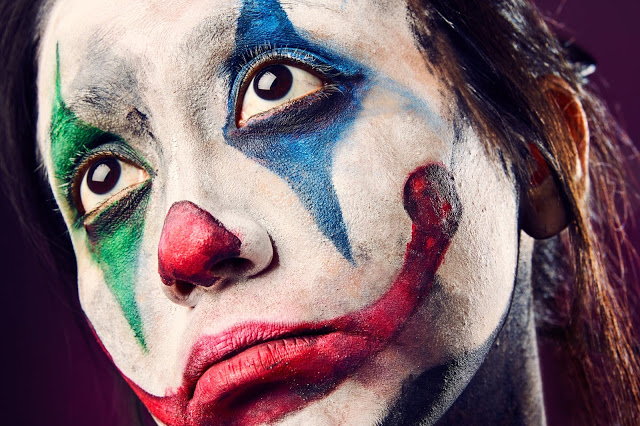In 1988, Alan Moore’s “Killing Joke” unveiled one bad day and spiral into a chemical plant that reduced a sane man to the living lunacy known as The Joker. In 2019, one simply soaks alone in a lifetime of society’s selfish viciousness to devolve into a maniacal malcontent in makeup.
Such is a main motif of “Joker.” The 2019 Clown Prince of Crime spiritually serves the throne occupied by oft-overlooked 1983 Martin Scorsese classic “The King of Comedy.” Meager mentally ill man Arthur Fleck (Joaquin Phoenix) naively aspires to bask in the boisterous glory of being a successful comedian. Unfortunately, Fleck absorbs far more punchlines than he successfully delivers. Brutal battery often accompanies the verbal assaults, leading Fleck on a series of unfortunate events befitting of Lemony Snicket stories.
During a subway smackdown targeting Fleck, three men learn that even a wounded dog is still most dangerous when cornered. Fleck then ensures the rest of Gotham will forever remember the man the city always forgets.
Gotham is not the dazzling hotbed of upward mobility most associate Batman’s domain with. Beautiful cinematography brings director Todd Phillips’ volcanic vision to life. Zoomed shots capture every painful pore and grimace. The morbid, at best morose tone derives from a setting often engulfed in an urban inferno. Divided citizens watch in horror or glee as Gotham burns, the flames arresting Gotham’s spirit in a perhaps permanent coma of chaos. The gritty script and visuals ensure viewers know Gotham’s true identity lurks in the shadows and flickering street lamps, as opposed to the sparking signs falsely advertising glitz and glamour. Hildur Guðnadóttir’s versatile score is nothing short of stunning. Her work projects to be richly rewarded with an Oscar.
Though many audio and visual elements bring “Joker” to an elite artistic level, Phoenix’s acting spearheads the experience. The magnificent maestro delivers an acting masterclass, acing the test of time by conveying searing emotion by fusing flamboyance with subtlety. Aspiring actors should take notes. Already capturing rarefied greatness, Phoenix’s performance should also seize the Oscar that eludes the brilliant actor’s overflowing trophy case.
There are many tools in the master craftsman’s gargantuan toolbox that Phoenix expertly utilizes to build arguably the greatest performance of this decade (though Daniel Day Lewis as Abraham Lincoln may present an articulate rebuttal, among a few others). Versatile facial expressions and vocal deliveries produced from a barbaric blender of anguish, hopelessness and insanity are cornerstones. However, the secret ingredient in Phoenix’s recipe for immense success is a heaping helping of physicality.
Phoenix maximizes the fruits of his laborious 52-pound weight loss. The slimmer frame unlocks a mesmerizing, somewhat hypnotic fluidity in his movement. Phoenix prances and steps with swift swagger when appropriate. However, when rambunctious radiance gives way to hopelessness, his body morphs to the caveman-esque shuffling relentless heckling and mental illness frequently confines Arthur to. Phoenix’s eyes are amazingly as agile as his legs. Casual viewers and cinephiles marvel in unison at the actor’s ability to control the light in his eyes that almost tangibly flickers and fades from scene to scene. The eyes are the window pane to the soul, but Phoenix’s voice commands that watchers hear the howling winds of mood change. For example, an instant shift in vocal gears to a guttural utterance of “You’re awful” drives the climax into chaos after revving audience anxiety with dark humor.
Like a wise baseball manager Phillips realizes his ace is pitching a perfect game and accordingly gives Phoenix an unabridged 122-minute moment of glory. That said, the entire supporting cast performs well. Robert De Niro as late-night talk show host Murray Franklin stands out in support. Knowing that age has wrinkled De Niro’s face but hasn’t touched his performing prowess, Phillips uses the icon sparingly, but entrusts him with key moments. De Niro’s biggest contribution involves verbally exchanging with Phoenix in a well-built, well-executed crescendo. This chilling scene will likely have viewers singing praises and muttering obscenities for decades.
The climax represents only one of numerous polarizing film aspects. Various media outlets expressed trepidation regarding this movie’s violent nature and potential to facilitate another tragedy. Reports of catering to incels are grossly exaggerated. Rather than stooping low, “Joker” places mental health advocacy on a pedestal. In fact, the entire story acts as an extreme case study, showing the potential horrors when society’s standard of care regarding proper mental health treatment is abysmal.
Of course, “Joker” will not receive angel wings anytime soon. Fransisco Goya could not paint a picture more effective at eliciting uneasy responses than this film’s frequently haunting cinematography and heavy material combines to produce. Undecided moviegoers should know that “Joker” is no laughing matter to those with squeamish eyes or unhealthy minds. The film is fully clothed in graphic violence, mental health mistreatment and depression. Those who get their kicks from the likes of Bill Hicks receive tasty comedic relief, but those who don’t like their coffee and comedy black won’t find the humor palpable.
When credits roll, many conversations will ensue, not all of them delivered in a loving tone . However, art needs to be the first word on the tip of the collective tongue. Although unwavering darkness covering sensitive subjects renders it difficult to view repeatedly, “Joker” leaves an unforgettable first impression. The film emerges from the shadows an ebony masterpiece, gripping the mainstream with a ferocity unseen in years.
Rating: 5/5













